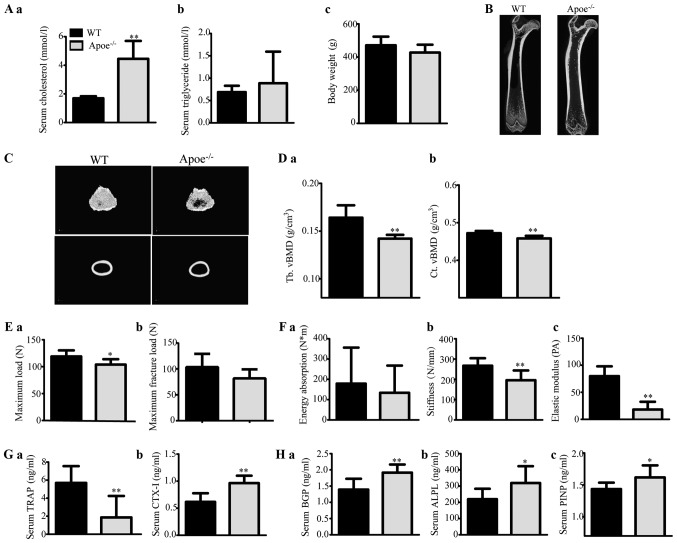Figure 2.
Effects of endogenous hypercholesterolaemia induced by ApoE knockout on male rats. (A) Serum (a) TC and (b) TG levels, and (c) body weight of the rats. (B) Representative 2D mCT images showing the trabecular and cortical microarchitectures of the femurs of each group. (C) Representative 3D mCT images showing the trabecular microarchitecture of the distal femur and the cortical microarchitecture of the midfemoral diaphyses. (D) Trabecular volumetric BMD (Tb. vBMD) (a) and cortical volumetric BMD (Ct. vBMD) (b) of the femur, as analysed via mCT. (E and F) The bone biomechanical parameters of the femoral diaphysis were calculated using a three-point bending test, and the maximum load (E-a), maximum fracture load (E-b), energy absorption (F-a), stiffness (F-b) and elastic modulus (F-c) of the femoral diaphysis were analysed. (G) The levels of the serum bone resorption markers TRAP (a) and beta-CTX (b) in rats were measured by ELISA kits. (H) The levels of the serum bone formation markers BGP (a), ALPL (b) and PINP (c) in rats were measured by ELISA kits. *P<0.05 and **P<0.01 vs. the corresponding WT group. TC, triglyceride; LDL-C, low-density lipoprotein cholesterol; HDL-C, high-density lipoprotein cholesterol; TG, triglyceride; BMD, bone mineral density; BGP, bone glaprotein; ALPL, alkaline phosphatase; PINP, type I anterior collagen amino terminal peptide; WT, wild-type; ApoE−/−, ApoE-knockout (KO).

